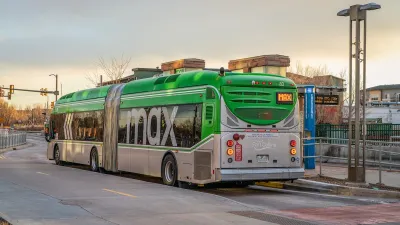Even when a community has thrown its full support behind a transit project, questions of funding and operations can create controversy. The next few months will be worth watching for Montgomery County, Maryland's proposed BRT system.
Kelly Blynn reports on an ongoing question about how to fund the operations of a proposed bus rapid transit line in Montgomery County.
"Montgomery County needs to find a funding stream in order to make its Bus Rapid Transit happen, and county executive Ike Leggett is exploring the possibilities. One of them is an independent transit authority, and while that may still work, the county needs to both vet it more thoroughly and weigh other options."
Leggett, however, already proposed an independent transit authority at the end of January, only to rescind that suggestion last week, "citing a need for a more in-depth community review," according to Blynn.
Reporting for the Washington Post, Bill Turque describes the response to the independent transit authority idea as "questions and withering criticism."
Blynn also describes the plan, approved in late 2013, as popular with Montgomery County residents. According to Blynn, "a survey of 400 residents in early 2014 found 71% of residents support BRT. They see BRT as a way to revitalize aging commercial corridors, make the area safer for people walking and on bikes, ease traffic congestion, and decrease air pollution."
Finally, Blynn states support for the idea of creating an independent transit authority with a dedicated funding stream: "Similar structures have worked well, primarily at regional scales, to provide laser-focus to build and finance new transit systems such as a streetcar in Pima County, AZ. Local funding and oversight for BRT may be more important than ever given the new Governor's expressed interest in cutting transit investment."
FULL STORY: How should Montgomery County fund and build Bus Rapid Transit?

Planetizen Federal Action Tracker
A weekly monitor of how Trump’s orders and actions are impacting planners and planning in America.

San Francisco's School District Spent $105M To Build Affordable Housing for Teachers — And That's Just the Beginning
SFUSD joins a growing list of school districts using their land holdings to address housing affordability challenges faced by their own employees.

The Tiny, Adorable $7,000 Car Turning Japan Onto EVs
The single seat Mibot charges from a regular plug as quickly as an iPad, and is about half the price of an average EV.

With Protected Lanes, 460% More People Commute by Bike
For those needing more ammo, more data proving what we already knew is here.

In More Metros Than You’d Think, Suburbs are Now More Expensive Than the City
If you're moving to the burbs to save on square footage, data shows you should think again.

The States Losing Rural Delivery Rooms at an Alarming Pace
In some states, as few as 9% of rural hospitals still deliver babies. As a result, rising pre-term births, no adequate pre-term care and "harrowing" close calls are a growing reality.
Urban Design for Planners 1: Software Tools
This six-course series explores essential urban design concepts using open source software and equips planners with the tools they need to participate fully in the urban design process.
Planning for Universal Design
Learn the tools for implementing Universal Design in planning regulations.
Smith Gee Studio
City of Charlotte
City of Camden Redevelopment Agency
City of Astoria
Transportation Research & Education Center (TREC) at Portland State University
US High Speed Rail Association
City of Camden Redevelopment Agency
Municipality of Princeton (NJ)



























